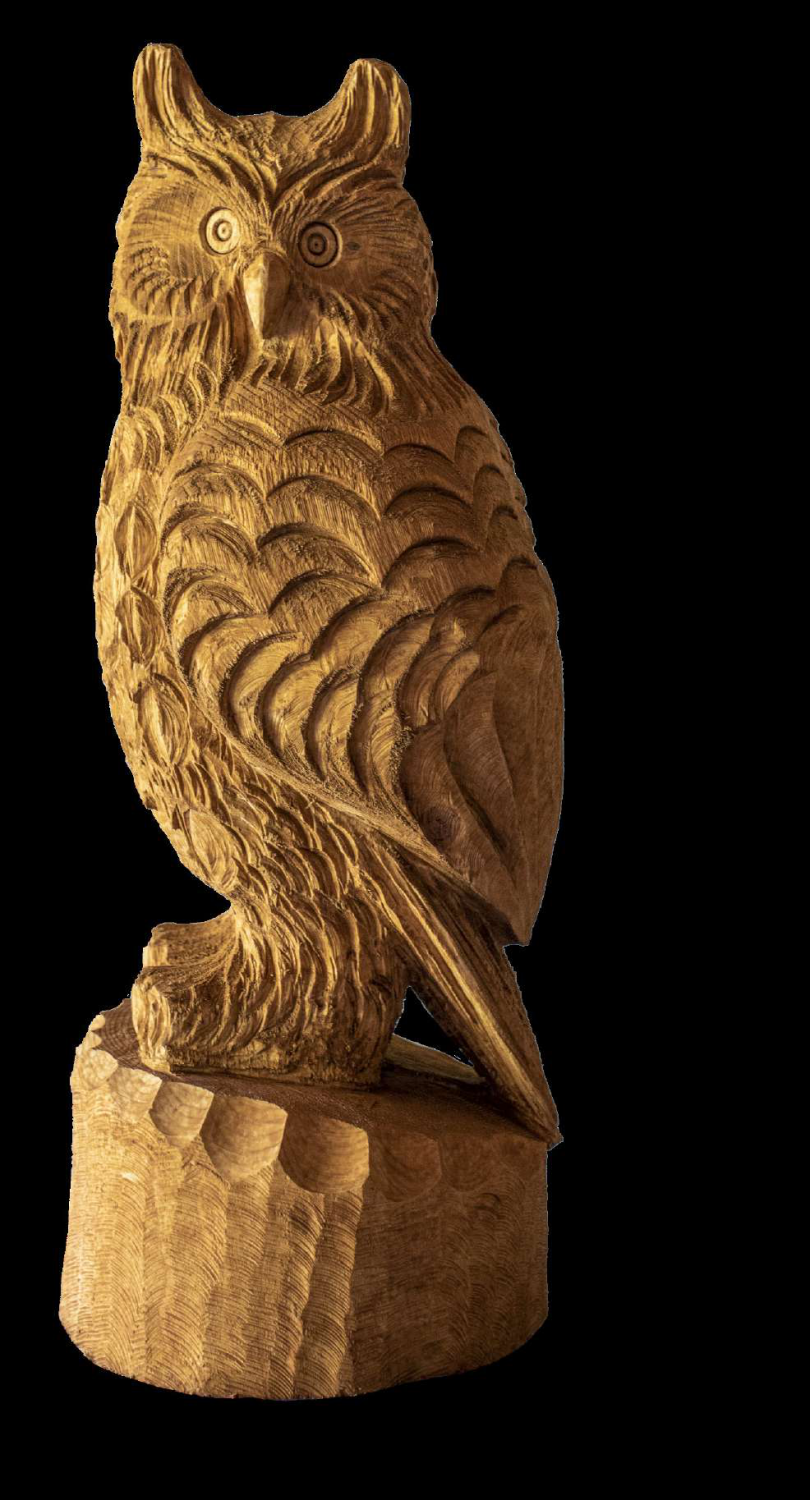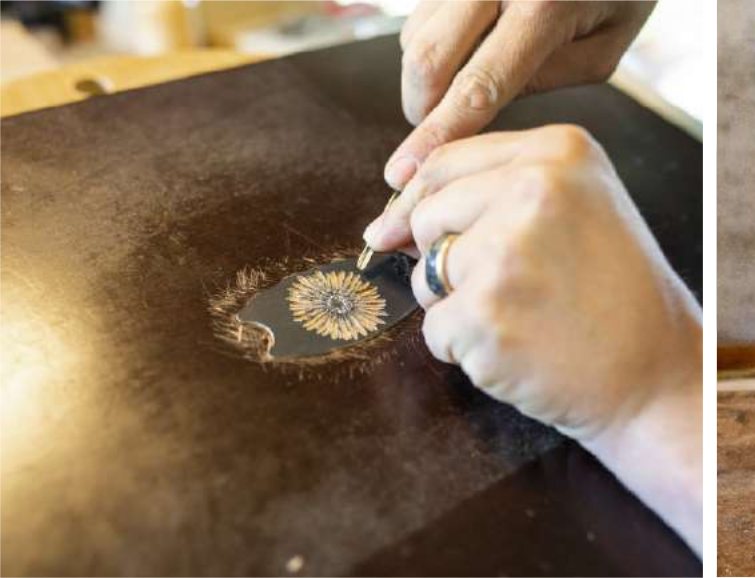Master craftsman
25.06.2022 TraditionsMario Frautschi from Turbach is a multi-talented craftsman with a passion for his art – carving wood by hand in the traditional manner to create magnificent sculptures. He also carves intricate designs in leather and has been known to sculpt igloos in the winter too. GstaadLife met with Mario to talk wood carving, tradition and inspiration.
What attracted you to wood carving?
It’s quite simply my passion. I believe it’s to do with who you are as a person. I don’t come from a family with a long tradition of wood sculpting – it’s just who I am.
I began carving wood as a child. I’ve always had a strong imagination and it just continued from there. I was always encouraged and told “you’re an artist” and indeed that is what I am. That’s how it is sometimes – whether you like it or not – you can do nothing other than use the talents you’ve been given. It’s worked well for me. In 2012 I completed my training at the school for wood sculpting in Brienz and have been working with clients ever since.
What is your favourite aspect of your work?
I find it really interesting to talk with clients and understand what most appeals to them. Then it’s my job to realise their vision. That’s the most wonderful thing – to give shape to a design, to find the best form, to bring it to life with your eyes. It’s an incredible feeling.
Please take me through your process for creating a new piece.
First, I make a sketch, then build a model using modelling clay. This means I can easily add or remove clay as I develop the piece. I then share this with my client so they can say if it’s what they were expecting and if they’d like to request any changes. I then make a plaster cast of this second model so I can reuse the modelling clay and only then does the actual work on the wood begin.
If I’m making a large sculpture, the model is only a small-scale version. I then use tools to transfer the small measurements over and scale up the piece to its desired actual size. It’s important to check that all dimensions stay in sync and that both sides of a sculpture are symmetrical. On a face, for instance, I have to be sure one eye doesn’t drop beneath the other. I have a system to keep things on track and avoid making big mistakes, because with wood when it’s gone, it’s gone!
How do you balance tradition with innovation?
Whatever project I’m working on, the goal is twofold: create a piece that looks good in a way you can easily implement.
For instance I’m currently working on a sculpture that needs to look good from afar. I’ve simplified the form so that it’s clear what the piece depicts and am now styling it in line with the desired end result.
For really large sculptures I use a chainsaw and angle grinder, but when it comes to small details like eyes, I use a chisel. This enables me to really get behind the tool and close to the piece I’m creating.
What is the most difficult project you’ve ever worked on?
One of the biggest challenges a wood carver faces is to consider whether a project will actually work or not. It’s something you have to weigh up before you start carving and something you have to continually evaluate as the project progresses. If things look like they’re starting to go wrong you then have to figure out a way to make the piece still look good.
I once carved a huge eagle with outstretched wings and sharp claws gripping a ledge. That was extremely challenging. I not only had to get the sizing of the claws exactly right to ensure a snug fit with its base, but also carve the eagle’s body so that it was the correct size and wouldn’t fall over. That was really difficult. Yes, I remember that particular project well!
You also do carpentry? What’s the difference between wood carving and carpentry?
They’re two very different worlds and I enjoy them both in their own manner. The essential difference is that in carpentry everything has to be very precise
– you’ll be cutting wood to within nine-tenths of a millimetre with machines. But wood carving is about working by eye – you have a strong vision of what you’re creating and a centimetre here or there is of no significant consequence. It’s totally up to you as the artist.
In carpentry there is a lot of preparation before the actual work starts to ensure the machines are programmed correctly. This is clearly important as so many items will depend on those measurements. On the other hand the preparation in wood sculpting is more about trying things out and deciding on a design rather than making exact calculations. In fact, to a large degree you just get started with your hands, then develop the piece as the work proceeds. Art is a kind of illusion; if you succeed in creating the illusion the piece turns out well.
Perhaps the biggest difference is that wood carving is about working by hand to produce one-off pieces. Everything I create is unique – there’s only one of them in the world, whereas carpentry is about mass production using the same dimensions, the same angular shapes, the same everything and usually as quickly as possible.
Let’s talk about engraving chalet facades. That must be high stress – do you worry about making a mistake?
It’s fine. I have a routine, a process. First, I put the design on paper and fix that to the chalet. Then it’s just a case of chiselling out the images and lettering according to the design.
It’s quite hard work, though. You’re working upright so you feel it in your arms and your muscles get a real workout. And while I’ve never made a mistake, I have tools and techniques to remedy any situation that may occur and keep it under control.
You also carve leather. How does that differ to working with wood?
The main difference is that leather carving is extremely delicate work. You have the outer black layer, a thin blue layer then underneath the actual leather. It’s wafer-thin so you can’t just get in there and start carving. You have to work quite gently, but when you know what you’re doing, it goes quite quickly. I find the work enthralling.
A lot of the leather carving work is for cow bell straps. You can put any kind of motif on leather and over the years I’ve carved many different designs – even penguins. It’s fun.
And you also make sculptures from snow and ice?
Yes, a few years ago I helped to make the igloo village on the Saanersloch. When you create an igloo, the wall curves in so the snow always seems to be flying into your face! Although it’s cold, the work is relatively easy because you can continue to pack on more snow as needed. However when it comes to ice sculpting then it’s like wood – when it’s gone, it’s gone.
How do you see the future of wood carving?
Wood carving by hand is actually considered rather exotic. In fact there are only one or two schools that teach this craft across the whole of Switzerland. I know this doesn’t seem like a lot, but then not everyone is an artist. As a craftsman working with your hands you have the opportunity to create unique pieces of art. True oneoffs. From this perspective the future looks bright, but there is also some uncertainty. The increase in technology like 3D printing means more is being digitalised and there are now fewer and fewer true craftsmen working with their hands. I think you just have to remain flexible and always see the glass half-full. At least that’s how it seems to me.
I have a really positive mix of clients, split about 50/50 between people who live in the Saanenland the whole year round and visitors with second homes. This shows that wood carving isn’t just something for tourists, but a craft valued in the region.
In looking to the future I also aim to sell my work through my website. I think there’s definitely an opportunity to grow in that direction.
How can we get more young people involved in wood carving?
There are initiatives to spread the word. Just yesterday I led a group workshop on wood carving at a hotel. While some attendees declared the work to be too hard and physically demanding, those who decided to stay right to the end got enormous pleasure from completing their carvings. As with anything, if the interest is there, you’ll find the patience. I’m optimistic.
ANNA CHARLES







